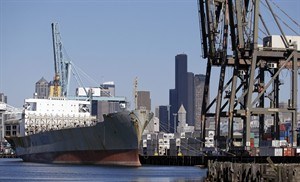
FILE - In this Nov. 11, 2014 file photo, an empty container ship is moored at the Port of Seattle's seaport and in view of stacked containers ashore on the Duwamish Waterway, in Seattle. The Commerce Department reports on the U.S. current account trade deficit for July-September quarter on Wednesday, Dec. 17, 2014. (AP Photo/Elaine Thompson, File)
December 17, 2014 - 6:14 AM
WASHINGTON - The U.S. current account trade deficit widened slightly in the July-September quarter, largely due to foreign institutions paying less in fines and penalties to the U.S. government.
The Commerce Department said Wednesday that the deficit in the current account rose to $100.3 billion in the third quarter, up 1.9 per cent from a revised $98.4 billion deficit in the April-June period.
The increase occurred despite a drop in the trade deficit for goods and services, reflecting cheaper oil prices and a stronger dollar.
The deficit widened because fines collected by the U.S. government from foreign institutions fell to $27.8 billion from $40.1 billion in the previous quarter, a 31 per cent decrease. In the April-June period, the government had fined the French bank BNP Paribas $9 billion for violating sanctions against Iran, Sudan and Cuba.
The current account is the broadest measure of trade, covering not only the flow of goods and services but also investment flows. It faces downward pressure because the dollar has increased in value relative to other currencies and oil prices have fallen by almost 50 per cent since June.
The average price of a barrel of oil has dropped below $56 from a summer high of $107. That reflects weakening global demand as Japan has tumbled into a recession, Europe staves off a slowdown, China's economy loses momentum and Russia copes with its collapsing currency. But U.S. consumers have largely been insulated from these pressures and benefited from less expensive oil.
At the same time, the global slowdown has caused more investors to crowd into the dollar as a relative safe haven. The dollar appreciated 7.1 per cent against other major currencies during the July-September quarter.
The current account is still relatively low by historical standards. The quarterly deficits regularly topped $150 billion in the four years before the Great Recession of 2007-2009.
News from © The Associated Press, 2014